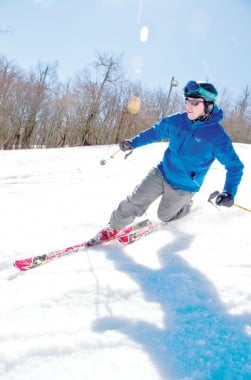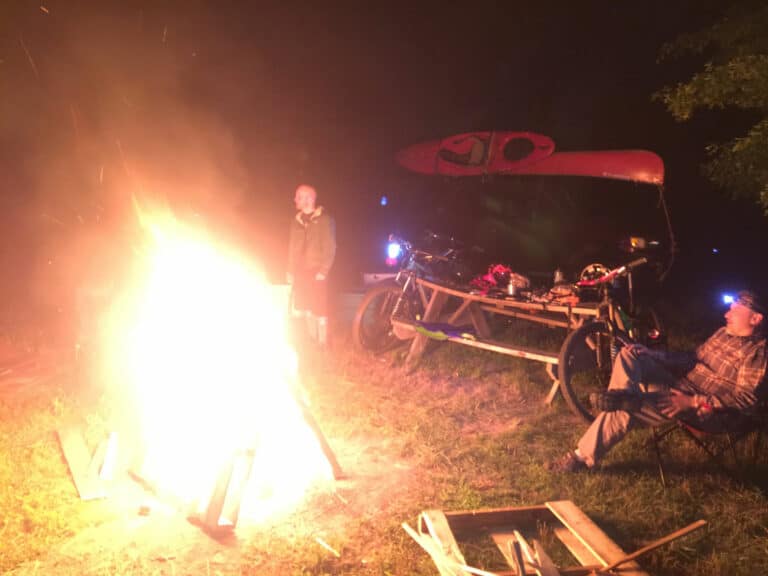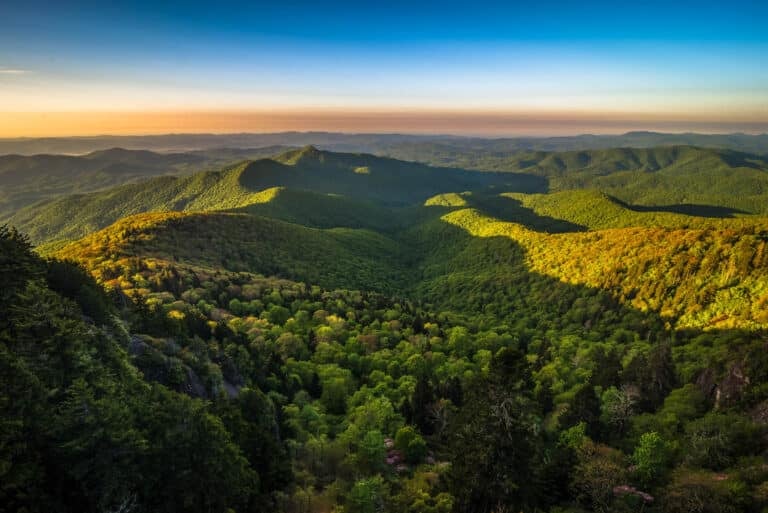Flying low: Once under the radar, telemark skiing is beginning to hold an edge in the blue ridge.
The Quiet Revival of Telemark Skiing
Drop knees, not bombs….Free your heel, free your mind…Trust me, I tele.
These axioms, and more not suitable for print, adorn bumpers, roof racks, and Nalgene bottles across the ski landscape. They represent the modern attitude toward an art almost as old as sliding on snow: the telemark ski turn. To watch a master of the technique as they genuflect gracefully down a slope is like watching the birth of modern skiing; like watching evolution in action. The telemark ski method ushered in a new era, bridging the gap between utilitarian cross country and recreational downhill skis.
It all started with one man: a Norwegian named Sondre Norheim. In 1868, Norheim laid down the first telemark turns in a ski competition in what is now Oslo, the general public’s first introduction to the new technique of using the free heel of cross country bindings to bend and pull the uphill ski beneath the body while extending and bending the downhill leg forward to execute a turn.
Norheim’s technique, however, was soon passed over for the easier fixed-heel parallel turn and almost died out forever. The cultural changes to the American landscape in the late 1960s and 1970s led to a telemark revival, when ski bums in Crested Butte and Vermont rebelled against the crowded, groomed resorts in favor of exploring the backcountry on cross country skis and bringing back the telemark turn. The 1990s brought plastic boots to replace leather, fat skis to replace skinny, and modern telemark took off in the U.S.
Telemarking is certainly still an alternative way to ski, especially in the Southern Appalachians where it is still relatively unknown outside of bubbles like Canaan Valley. In the mountains out West, telemark skiers have a reputation akin to dirtbag climbers. Part of this is economical—telemark gear can get you deep into the backcountry and also perform at the resort—but a larger part is cultural. Much like fly fishing or the singlespeed mountain bike, telemark is not the easiest or fastest way, but it has an almost spiritual appeal to those who do it.
This feeling is what hooked Boone, N.C. social studies teacher and part-time ski patroller Russ Hiatt on the sport. Having grown up skiing in Utah, he picked up telemark as a way to challenge himself on the comparatively tame slopes of the Southeast.
“Certainly, there’s an attraction about it because it’s different,” Hiatt says. “It’s challenging in its own way. It’s not like alpine skiing is that easy, but this adds a whole new aspect to it and that attracts certain people. To me it’s a lot like surfing; I think it’s just a lot more soulful. It’s not about getting to the bottom of the hill the fastest; it’s how you get to the bottom of the hill.”
Since the technique has so many moving parts, tele skiers are free to experiment with the depth of their stance, their transition, and their balanced body movements, putting a personal stamp on each turn. The free heel of the binding allows for easy touring without changing the setup, permitting telemarkers the freedom to roam the hills for fresh tracks anytime. The very act of the turn, with its emphasis on fluid motion and connectivity, reminds one of other spiritual movements like tai chi— hence all the “free your mind” and “let go, just feel it” talk that purveys many tele conversations. This individuality, along with the funny boots, give telemarkers a camaraderie that may be missing from the alpine and snowboard sects.
“Because it’s different and has a smaller following, it really is much more about community,” says Hiatt. “It’s kind of like this instant connection. When you see another free-heeler, you already have this instant thing that separates you from the crowd.”
It was this exact instant connection that put Hiatt on the path to help create Tele-Fest at Beech Mountain in 2011. After a day on the mountain and a little bar-napkin planning with a few others, he created Tele-Fest, now in its third year. It has even added a mini film festival. The festival is a fun way to get together and drop knee, but it also serves a larger purpose: access.
Gatherings like Tele-Fest allow the exchange of ideas and knowledge, but also the exchange of gear. As the sport gains popularity in the South from its grassroots beginnings, Hiatt hopes resorts and retailers will begin to recognize telemark as something worthy of their resources.
“Yes, we’re a niche group, but a niche group that hopefully will be worth a resort’s investment in a rental fleet,” he said. “That’s still our goal, and we’re working towards it.” •
The Tele Turn
The basic telemark turn is made by doing the exact opposite that you have learned throughout your skiing career. In the parallel turn, your uphill ski is generally supposed to be in front of your downhill ski. This is not true for the telemark turn. If you want to turn to the right, you pull your right ski, uphill ski, back underneath your body, flexing at the forefoot and the knee. At the same time, your downhill ski, left ski, extends forward, flexing at the hip and knee. This is a similar motion to doing your simple lunge during that exercise class you hate. Oh, you don’t do lunges? Then you probably won’t get very far on telemark skis. The technique is virtually one lunge after another, except at speed, on snow. Interested now?
Upcoming Telemark Events
Tele-Fest
January 12, 2013 • Beech Mountain, N.C.
Telepalooza
February 2-3, 2013 • Seven Springs, Penn.
North American Telemark Association Workshop
January 19-20, 2013 • Canaan Valley, W.VA.
North American Telemark Association Telemark Adventure Tour
February 2-3, 2013 • White Grass/Dolly Sods, W.VA.








